Before you embark on your adventures, choosing what snowshoeing clothing you wear can significantly influence your experience. Proper winter clothing helps keep you warm and dry, and wearing or bringing multiple clothing layers can help you adapt to changing conditions while out.
The appropriate clothing is essential for longer snowshoe outings where you’ll be away from home. If you are snowshoeing near home (at a local park a block away, for example), you can quickly return to your house if needed. Thus, there is some flexibility in what you can wear, and you may be able to wear everyday clothing. The most important consideration to remember when choosing what to wear when snowshoeing is that you stay warm and dry to avoid safety hazards when snowshoeing.
Also, you may not need to purchase new snowshoeing clothing and may already have items in your closet that will work for your outing. You can even salvage clothing with repairs, like this puffy repair using Vinyl Mender, instead of purchasing a new product.
To help you choose what to wear, we’ll provide tips about how to layer, what materials to look for in your attire, and some of our favorite items.
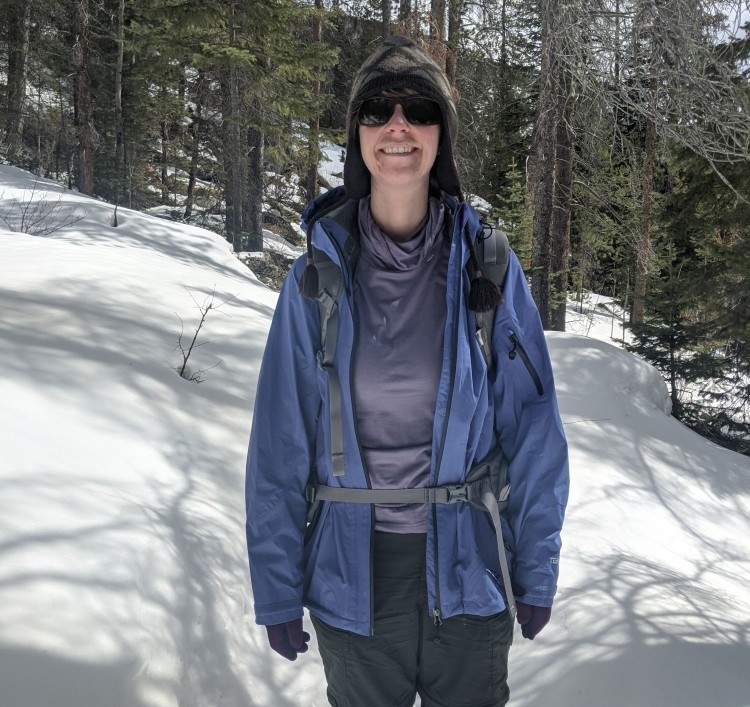
Make sure to dress in layers while on your outing, know your material and protect those extremities. Photo: Paul Wowk
Dress In Layers
Winter means quick-changing weather, so you must ensure you’re comfortable, warm, and dry. The best way to adjust is by dressing in layers.
You can remove or add layers as needed to maintain an appropriate body temperature as you get warmer or colder while on your hike. Also, you’ll most likely be working up a sweat and burning calories on your outing, so layers help you to avoid overdressing.
We discuss the three layers below, but depending on the temperature, you may not need all three. For example, on warmer days (not actively raining or snowing), you may only need a shirt (base layer) and a light jacket (outer layer).
Read Next: Thinshell Layering: A Two Layer System
Base Layer
Your base layer is the layer closest to the body, such as a form-fitting shirt or pair of tights. Ideally, the base layer should be moisture-wicking or able to pull moisture away from your skin.
Many base layers come in different weights: lightweight, midweight, and heavyweight. As noted in the names, lightweight base layers will be your thinnest fabric, and heavyweight will be your warmest. Typically, midweight base layers are a great option for snowshoeing unless it’s an unusually warm or cold day.
Base Layer Materials
Common base layer materials are synthetic materials such as polyester, wool or merino wool, and silk. Typically, base layers are made of one of these materials or a blend.
The fabric you choose depends on your preference and what your body needs. For example, you may prefer wool or merino wool if you’d like more insulation, polyester if you prefer the least expensive, or silk if you’d like a very lightweight long underwear fabric.
Read More: Analysis: Will Merino Wool Keep Us Warm While Snowshoeing?
Base Layer Examples
Here are a few examples of base layers we recommend.
Men
REI Midweight Long-Sleeve Base Layer
Purchase at REI
Smartwool Merino 250 Bottom
Purchase at Backcountry
Women
Patagonia Capilene Midweight Crew (long-sleeve)
Purchase at Patagonia
Icebreaker Oasis Legless Leggings
Purchase at REI

Merino wool can make excellent fabric for a base layer since it’s insulating yet breathable. It also has natural thermal regulation and odor-resistant properties. Photo: Paul Wowk
Mid-Layer
Mid-layers serve as your insulator on your snowshoeing outing and are incredibly important! Typically you wear your mid-layer over your baselayer and under your outer layer (hard shell jacket). However, if it’s warm and not raining/snowing, you can wear your mid-layer without an outer layer.
Mid-Layer Material
Standard mid-layer fabrics include fleece, down, synthetic down, or polyester.
Like your base layer fabric, which mid-layer material you choose is based on personal preference and body temperature. For example, you can use a synthetic down jacket on freezing days (like a puffy), a fleece jacket on moderate temperature days, and a polyester hoodie on warm days.
Read More: Celebrating a Century of the Puffy Coat
Mid-Layer Examples
Here are a few mid-layer examples that we recommend.
Men
Patagonia Nano Puff Jacket
Purchase at Patagonia
Cotopaxi Sombra Sun Hoodie
Purchase at Backcountry
REI Groundbreaker Fleece Jacket 2.0
Purchase at REI
Women
Patagonia Nano Puff Jacket
Purchase at Patagonia
North Face HyperLayer Flash Dry (FD) Hoodie
Purchase at Amazon
REI Groundbreaker Fleece Jacket 2.0
Purchase at REI

Puffy jackets are a great mid-layer if used as an insulator or outer layer to protect you from the elements. Photo: Susan Wowk
Outer Layer
As the last layer of your snowshoeing clothing, the outer layer (jackets and pants) protects you from elements like wind, rain, or snow. Keeping out the elements will help keep you warm and dry.
Outer Layer Materials
Typically, outer layer jackets and pants will come with a DWR (durable water repellent) finish or made of Gore-Tex to help keep out the elements. In addition, jackets are either hardshell (tough exterior) or softshell (soft, more moveable exterior).
For colder days with heavier rain/snow, a hardshell jacket offers increased protection as an outer layer. Typically hardshell jackets have a hood, are waterproof, are not stretchy, and are durable. If it’s frigid, you can wear a softshell jacket (like a puffy) under a hardshell jacket for extra warmth on chilly days.
Outer Layer Examples
Here are a few outer layer examples that we recommend.
Men
REI Groundbreaker Rain Jacket 2.0
Purchase at REI
Marmot Carson Jacket
Purchase at Backcountry
Marmot Arch Rock Pant
Purchase at Backcountry
Women
REI Active Pursuits Shell Jacket
Purchase at REI
Burton Jet Set Jacket
Purchase at Moosejaw
Kuhl Frost Soft Shell Pants
Purchase at REI

A puffy softshell jacket and a rain jacket are great to pair for snowshoeing. If the weather is warm, wear a puffy or rain jacket. Or, if the weather is cold, pair the two together for extra insulation. You can switch out the rain jacket for a warmer snowboard/ski winter jacket for very cold conditions. Photo: Paul Wowk
Don’t Forget Your Extremities
In addition to choosing the proper snowshoeing clothing for your body, remember to cover your hands, feet, and head properly. These extremities are also essential to protect appropriately on your snowshoe outings.
Footwear
Whether running, climbing, backpacking, or walking, always try to match your snowshoeing style and the weather.
Choose shoes or boots for snowshoeing (like these six options) that are ideally waterproof and will keep your feet warm, dry, and comfortable. If you don’t have waterproof boots or shoes, you can always treat them with sprays or waxes, such as Nikwax, to make them more water-resistant.
Regarding socks, it’s recommended to use synthetic or wool socks (like these five options). But, of course, you can always layer your socks for extra insulation.
Read More: Snowshoeing Footwear: Tips for Choosing your Boot
Hands
You can choose to wear mittens or gloves (like these options) while on a snowshoe outing. Mittens tend to keep your hands warmer, but gloves have better finger dexterity (like when taking photos).
Look for gloves or mittens with waterproof features, like Gore-Tex, to protect hands in the snow. Keeping your hands warm and dry can help prevent cold weather injuries and safety hazards like hypothermia and frostbite.
Read More: Keep Your Hands, Feet, and Head Warm for Snowshoeing
Head
Covering your head will not only prevent body heat loss and protect you from sunburn, but hats help keep you warm. There are a variety of head coverings, including balaclavas, headbands, beanies, wide-brimmed hats, or athletic caps, that you can use to retain heat.
Beanies can be a regular go-to for snowshoeing. However, balaclavas help in extreme conditions, or you can use an athletic cap on warmer days to protect your skin in winter and from sunburn.
In addition to your head, make sure to also protect your eyes with a pair of sunglasses (here are a few for active lifestyles). Though there may be clouds, you may still be affected by ultraviolet exposure. Snow and water, particularly, reflect sunlight and can cause additional exposure to those UV rays.
Overall
By dressing in layers, paying attention to fabrics, and covering your extremities, you’ll be prepared for the weather conditions on your snowshoe outings.
Though we provided a few examples above, you may not need to purchase new items for your items and can use existing items from your wardrobe depending on the location and length of your trip. You can also re-purpose older items by repairing them (like this puffy repair).
What other tips do you have for choosing the appropriate clothing for snowshoeing? Please share your thoughts or additional questions in the comments below!
This article was first published on March 27, 2019. It was most recently updated on October 17, 2022.
Read Next: What To Bring When Snowshoeing: Top Accessories for the Day Hiker

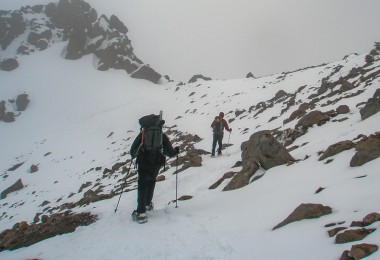
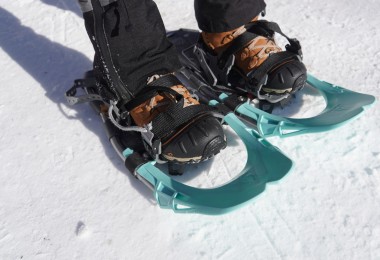
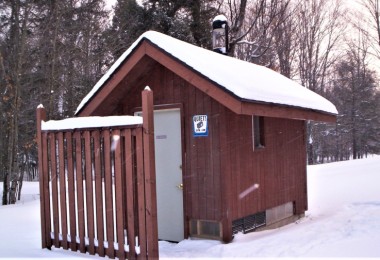
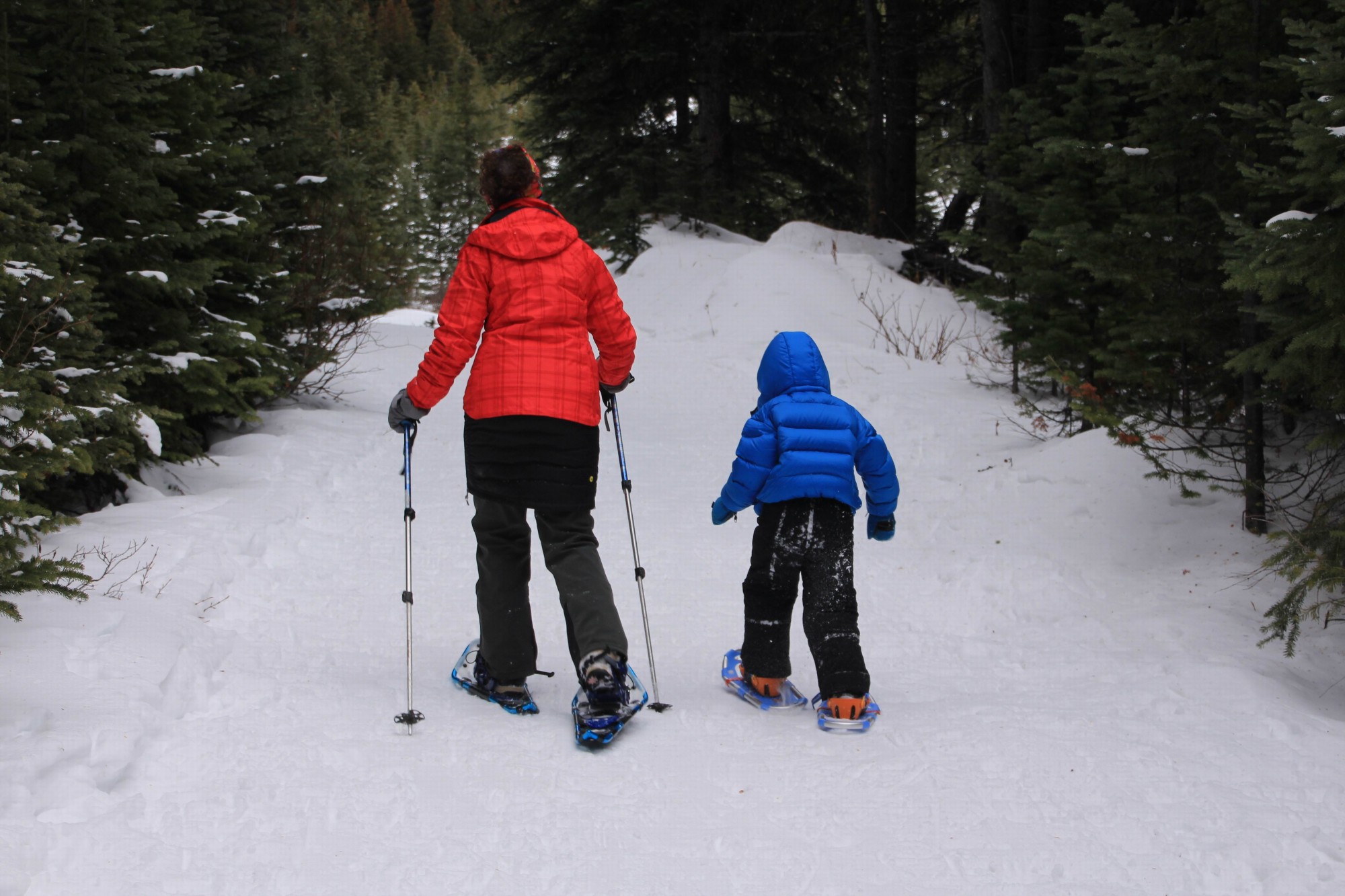

How does one prevent ice build-up on the bottom of snow shoes when the weather is mild?
That is a great question Phil and a common struggle during the spring snowshoe season. Typically snowshoes which have a polyurethane or Teflon coating will help prevent snow and ice build up on their own. I have heard of some using cooking spray or other lubricants such as ski or snowboard wax, petroleum jelly or WD-40 on the bottom of their shoes, but I haven’t tried these methods myself. If you do try these, I’d love to hear your thoughts about it and whether it works! I hope this helps!
use any kind of water proofing spray such as Atsko silicone water-guard.
Yes! Adding a water guard is a great tip! Thanks for sharing, Charles. -Susan, Editor